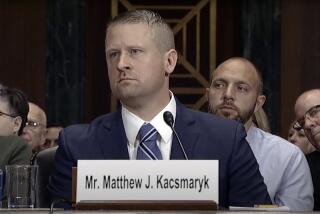Ads Bring Sex’s Consequences Home to Teens
- Share via
Susan Philliber, a New Yorker who spends her days analyzing human services programs, had one simple reaction to the ads she held in her hands from the National Campaign to Prevent Teen Pregnancy:
“Has Sarah lost her mind?”
Surely campaign director Sarah Brown, the politically astute, former health care advisor to scientists and members of Congress, was kidding. Surely, these teenage tarts and thugs, each one branded with a different scarlet label like “cheap” or “reject” or “dirty,” weren’t really going to blast into print.
Oh yes, they are. Beginning today, the National Campaign, an established research and advocacy organization, will roll out six in-your-face ads designed to get kids talking about what can happen after a couple hits the sheets. Love notes and flowers are not among the possibilities.
Conceived by the advertising giant Ogilvy & Mather, the project is titled “Sex Has Consequences.” Fine print runs up the left side of each ad, playing with the bigger word in red. In the “cheap” ad, for example, the word is blazoned across the bust of a brunet wearing thick makeup, her blouse knotted above her navel. The tiny type says, “Condoms are CHEAP. If we’d used one, I wouldn’t have to tell my parents I’m pregnant.”
Brown, a former study director at the Institute of Medicine, has been quietly passing the ads around for review.
“These ads are not just more of ‘Let us tell you how to protect your health,’ ” said Isabel Sawhill, senior fellow at the Brookings Institution and the National Campaign’s president. “They’re about how to think about a boy who has just gotten your best friend pregnant, or how to keep your boyfriend.”
Sawhill showed the ads to Health and Human Services Secretary Donna Shalala. “I found them shocking,” Shalala said later, “but that’s the point. They’re designed to reach teenagers, not adults, in the magazines teens read and the Web sites they view. I think they achieve their goal. They cut through the clutter of all the messages bombarding teens and get them to think for themselves about the risks and responsibilities of pregnancy.”
Several magazines and Web sites have volunteered to run at least some of the ads for free--including CosmoGirl, MH-18, the Source, Teen People and Web sites managed by Oxygen Media. “My jaw dropped when I saw them,” said Amy Paulsen, executive editor of Teen People. “They’re edgy, unexpected.” The double play on words, she said, “respects teenagers’ intelligence.”
Public officials, including Frankie Sue Del Papa, Nevada’s attorney general, have volunteered to distribute the ads. “They are designed to make people talk about the issue, and I think they will,” Del Papa said.
But not everyone has been receptive. “The message is pretty negative,” said Michael McGee, vice president for education at Planned Parenthood Federation of America. “I know the intent is to portray pregnancy as the problem, but what you walk away with is the red line and the pictures. The kids are all losers.” He has no plans to send them to Planned Parenthood clinics.
Brown understands McGee’s reaction. Traditional sex educators prefer esteem-building phrases, she said, such as “Respect yourself,” or “Protect your dreams.” The National Campaign has talked that talk plenty in the five years it has been around.
But in magazines where female models in mink spread their legs for guys happy to see them, tasteful, feel-good ads are not enough, Brown contends. “Our new ads were never designed for community programs,” she said. “They were designed for magazines that kids read, like Spin and Vibe. In that environment, it takes a lot to get kids’ attention.”
More to Read
Sign up for Essential California
The most important California stories and recommendations in your inbox every morning.
You may occasionally receive promotional content from the Los Angeles Times.













